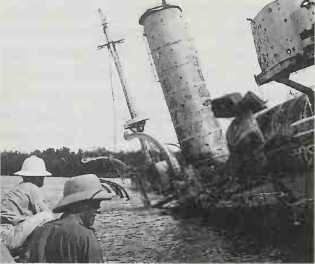East African campaign (191418). In August 1914, Col Paul von Lettow-Vorbeck, military commander in German East Africa, deemed it his duty to help the German war effort by posing a threat to the surrounding British and Belgian colonies.
Lettow-Vorbeck decided to mount a guerrilla campaign that would force the British to divert forces from other, more important, theatres. He chose as his target the Uganda railway, upon which the economy of British East Africa depended. His raids were highly successful; in two months, 30 trains were derailed and ten bridges destroyed.
The British reaction was to send troops from India to invade the German colony. The force, 8,000-strong, was landed at Tanga on November 8 1914. There it suffered a humiliating defeat at the hands of only 1,000 men under

Scuttled German cruiser. East Africa
Lettow-Vorbeck, and was forced to withdraw to Mombasa.
The British went onto the defensive until 1916, when the South African government provided fresh troops for an offensive. Lt Gen Jan Smuts was appointed Imperial c-in-c. In March 1916 he crossed the border in the Kilimanjaro area with three divisions, comprised of 27,000 British, South African, Indian and East African troops. At the same time, further British, Belgian and Rhodesian forces invaded the German colony from both the northwest and the southwest.
Lettow-Vorbeck, with a total force of never more than 3,000 Europeans and 11,000 askaris, evaded major engagements unless he had local superiority, and always withdrew before the British could pin him down. By the end of September 1916, Smuts had taken Dar-es-Salaam and had occupied the northern two-thirds of the German colony, but he had failed to trap the elusive Lettow-Vorbeck. The tse tse fly dismounted Smuts’s cavalry, and malaria and other tropical diseases so decimated his British, South African and Indian regiments that most had to be evacuated by the end of 1916.
The remainder of the campaign had to be fought with African troops, who could withstand the climate. In November 1917 Lettow-Vorbeck was nearly cornered in the southeast, but managed to escape into Portuguese East Africa with some 2,000 of his best troops. Still undefeated at the time of the Armistice in Europe, he Anally surrendered on November 25 1918. WGFJ.
East African campaigns, British
(January—November 1941) see
ERITREA, ITALIAN SOMALILAND and ETHIOPIAN CAMPAIGNS.
Eastern Front (1914-18) see Brusilov’s OFFENSIVE (1916-17); GALICIAN CAMPAIGN (l914); GORLICE-TARNOW OFFENSIVE (l915); TANNEN-BERG AND MASURIAN LAKES (l914); WARSAW, BATTLE OF (l914).
Eastern Solomons, Battle of the
(August 23-25 1942). Second major naval action of the Guadalcanal campaign, provoked by Japan’s ur, gent need to reinforce Guadalcanal. A Main Force (Vice Adm Hondo: carriers Shokaku and Zuikaku (Vice Adm Nagumo); seaplane carrier Chitose 3 battleships; 10 cruisers; 21 destroyers) steamed south from Truk, preceded by a Diversion Force (Rear Adm Chuichi Hara: carrier Ryujo; 1 cruiser; 2 destroyers), to lure the US carrier groups to battle. Meanwhile, Rear Adm Raizo Tanaka’s Landing Force (7 transports; 1 cruiser; 3 destroyers) was to put ashore 1,500 men. Deployed east of the Solomons was US Task Force 61 (Vice Adm Fletcher: carriers Saratoga, Enterprise and Wasp; 1 battleship; 9 cruisers; 18 destroyers).
Early on August 23, Landing Force was sighted by US aircraft, but air strikes from Henderson Field, Guadalcanal, and Saratoga failed because of bad weather.
Fletcher, deciding no major action was imminent, detached Wasp for refuelling. When Diversion Force was sighted by US aircraft early next day, Fletcher launched strikes from Saratoga and Enterprise - vainly attempting to divert them when Nagumo’s Main Force carriers were spotted. The US aircraft sank Ryujo; but counterstrikes from Shokaku and Zuikaku badly damaged Enterprise. A further strike from Saratoga damaged Chitose but failed to find Nagumo’s carriers. The Japanese lost 90 aircraft; the Americans only 20. That night, after a fruitless hunt for Fletcher’s force. Rondo withdrew. Early on August 25, Landing Force was attacked by USMC and usaaf aircraft from Guadalcanal and Espiritu Santo: a transport and a destroyer were sunk. The operation was abandoned, and Japanese attempts to reinforce Guadalcanal by day gave way to the “Tokyo Express”. RO’N.
Easter offensive (1972). Determined to make 1972 the year of “decisive victory”, Vietnamese communist forces launched an offensive on four fronts beginning March 30. Three People’s Army (pavn) divisions overran all 12 posts near the demilitarized zone that US Marines had turned over to the Army of the Republic (arvn) 3rd Division; the pavn 320th Division attacked arvn outposts throughout the central highlands: PAVN and People’s Liberation Armed Force (plaf) units besieged the Binh Long province capital; and PAVN units infiltrated from Cambodia to force suspension of “pacification” in the Mekong delta.
The offensive provoked President Nixon to order the mining of harbours and intensified bombing of North Vietnam in May. That pressure combined with high levels of American air support for the ARVN in the South helped to stall the offensive and very likely saved the arvn from collapse. However, communist forces remained in control of northern Quang Tri province and in a much improved position elsewhere. While the offensive failed to extract the concessions from the US, it revealed the arvn’s continued heavy dependency on American assistance and direct support. WST. See also an log, siege of.




 World History
World History


![Road to Huertgen Forest In Hell [Illustrated Edition]](https://www.worldhistory.biz/uploads/posts/2015-05/1432477693_1428700369_00344902_medium.jpeg)






